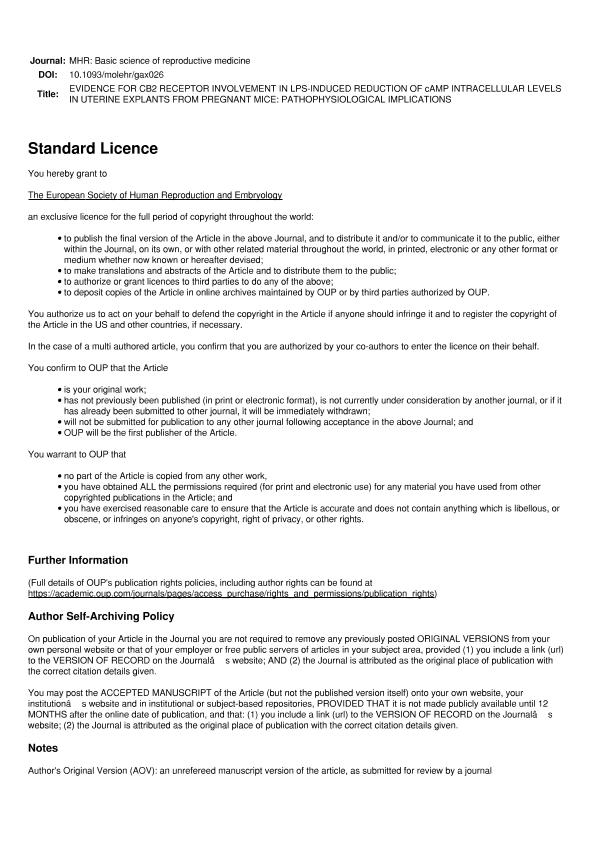Mostrar el registro sencillo del ítem
dc.contributor.author
Salazar, Ana Inés

dc.contributor.author
Carozzo, Alejandro Enrique

dc.contributor.author
Correa, Fernando Gabriel

dc.contributor.author
Davio, Carlos Alberto

dc.contributor.author
Franchi, Ana Maria

dc.date.available
2017-07-13T17:59:29Z
dc.date.issued
2017-05
dc.identifier.citation
Salazar, Ana Inés; Carozzo, Alejandro Enrique; Correa, Fernando Gabriel; Davio, Carlos Alberto; Franchi, Ana Maria; Evidence for CB2 receptor involvement in LPS-induced reduction of cAMP intracellular levels in uterine explants from pregnant mice: pathophysiological implications; Oxford University Press; Molecular Human Reproduction; 23; 7; 5-2017; 500-508
dc.identifier.issn
1360-9947
dc.identifier.uri
http://hdl.handle.net/11336/20349
dc.description.abstract
STUDY QUESTION: What is the role of the endocannabinoid system (eCS) on the lipopolysaccharide (LPS) effects on uterine explants from 7-day pregnant mice in a murine model of endotoxin-induced miscarriage? SUMMARY ANSWER: We found evidence for cannabinoid receptor type2 (CB2) involvement in LPS-induced increased prostaglandin-F2α (PGF2α) synthesis and diminished cyclic adenosine monophosphate (cAMP) intracellular content in uterine explants from early pregnant mice. WHAT IS KNOWN ALREADY: Genital tract infections by Gram-negative bacteria are a common complication of human pregnancy that results in an increased risk of pregnancy loss. LPS, the main component of the Gram-negative bacterial wall, elicits a strong maternal inflammatory response that results in embryotoxicity and embryo resorption in a murine model endotoxin-induced early pregnancy loss. We have previously shown that the eCS mediates the embryotoxic effects of LPS, mainly via CB1 receptor activation. STUDY DESIGN, SIZE, DURATION: An in vitro study of mice uterine explants was performed to investigate the eCS in mediating the effects of LPS on PGF2α production and cAMP intracellular content. PARTICIPANTS/MATERIALS, SETTING, METHODS: Eight to 12-week-old virgin female BALB/c or CD1 (wild-type [WT] or CB1-knockout [CB1-KO]) mice were paired with 8- to 12-week-old BALB/c or CD1 (WT or CB1-KO) males, respectively. On day 7 of pregnancy, BALB/c, CD1 WT or CD1 CB1-KO mice were euthanized, the uteri were excised, implantation sites were removed and the uterine tissues were separated from decidual and embryo tissues. Uterine explants were cultured and exposed for an appropriate amount of time to different pharmacological treatments. The tissues were then collected for cAMP assay and PGF2α content determination by radioimmunoassay. MAIN RESULTS AND THE ROLE OF CHANCE: In vitro treatment of uteri explants from 7-day pregnant BALB/c or CD1 (WT or CB1-KO) mice with LPS induced an increased production of PGF2α (P < 0.05) and a reduction of the tissue content of cAMP (P < 0.05). These effects were mediated by CB2 receptors since exposure to AM630 (a specific CB2 receptor antagonist) prevented these LPS-induced effects (P < 0.05). Collectively, our results suggest a role for the eCS mediating LPS-induced deleterious effects on reproductive tissues. LIMITATIONS, REASONS FOR CAUTION: Since our experimental design involves in vitro experiments of uterine explants, the extrapolation of the results presented here to humans is limited. WIDER IMPLICATIONS OF THE FINDINGS: Our findings provide evidence for the role of CB2 receptors in reproductive events as well as their participation as a mediator of LPS deleterious effects on reproductive tissues. LARGE SCALE DATA: None. STUDY FUNDING AND COMPETING INTEREST(S): Dr Ana María Franchi was funded by Agencia Nacional para la Promoción Científica y Tecnológica (PICT 2010/0813 and PICT 2013/0097) and by Consejo Nacional de Investigaciones Científicas y Técnicas (PIP 2012/0061). Dr Carlos Davio was funded by Agencia Nacional para la Promoción Científica y Tecnológica (PICT 2013/2050). The authors have no competing interests.
dc.format
application/pdf
dc.language.iso
eng
dc.publisher
Oxford University Press

dc.rights
info:eu-repo/semantics/openAccess
dc.rights.uri
https://creativecommons.org/licenses/by-nc-sa/2.5/ar/
dc.subject
Cb2
dc.subject
Lps
dc.subject
Endocannabinoid System
dc.subject
Miscarriage
dc.subject
Pregnancy Loss
dc.subject.classification
Fisiología

dc.subject.classification
Medicina Básica

dc.subject.classification
CIENCIAS MÉDICAS Y DE LA SALUD

dc.title
Evidence for CB2 receptor involvement in LPS-induced reduction of cAMP intracellular levels in uterine explants from pregnant mice: pathophysiological implications
dc.type
info:eu-repo/semantics/article
dc.type
info:ar-repo/semantics/artículo
dc.type
info:eu-repo/semantics/publishedVersion
dc.date.updated
2017-07-11T19:46:50Z
dc.journal.volume
23
dc.journal.number
7
dc.journal.pagination
500-508
dc.journal.pais
Reino Unido

dc.journal.ciudad
Bristol
dc.description.fil
Fil: Salazar, Ana Inés. Consejo Nacional de Investigaciones Científicas y Técnicas. Oficina de Coordinación Administrativa Houssay. Centro de Estudios Farmacológicos y Botánicos. Universidad de Buenos Aires. Facultad de Medicina. Centro de Estudios Farmacológicos y Botánicos; Argentina
dc.description.fil
Fil: Carozzo, Alejandro Enrique. Consejo Nacional de Investigaciones Científicas y Técnicas. Oficina de Coordinación Administrativa Houssay. Instituto de Investigaciones Farmacológicas. Universidad de Buenos Aires. Facultad de Farmacia y Bioquímica. Instituto de Investigaciones Farmacológicas; Argentina
dc.description.fil
Fil: Correa, Fernando Gabriel. Consejo Nacional de Investigaciones Científicas y Técnicas. Oficina de Coordinación Administrativa Houssay. Centro de Estudios Farmacológicos y Botánicos. Universidad de Buenos Aires. Facultad de Medicina. Centro de Estudios Farmacológicos y Botánicos; Argentina
dc.description.fil
Fil: Davio, Carlos Alberto. Consejo Nacional de Investigaciones Científicas y Técnicas. Oficina de Coordinación Administrativa Houssay. Instituto de Investigaciones Farmacológicas. Universidad de Buenos Aires. Facultad de Farmacia y Bioquímica. Instituto de Investigaciones Farmacológicas; Argentina
dc.description.fil
Fil: Franchi, Ana Maria. Consejo Nacional de Investigaciones Científicas y Técnicas. Oficina de Coordinación Administrativa Houssay. Centro de Estudios Farmacológicos y Botánicos. Universidad de Buenos Aires. Facultad de Medicina. Centro de Estudios Farmacológicos y Botánicos; Argentina
dc.journal.title
Molecular Human Reproduction

dc.relation.alternativeid
info:eu-repo/semantics/altIdentifier/url/https://academic.oup.com/molehr/article-lookup/doi/10.1093/molehr/gax026
dc.relation.alternativeid
info:eu-repo/semantics/altIdentifier/doi/http://dx.doi.org/10.1093/molehr/gax026
Archivos asociados
